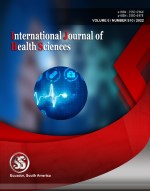Nursing care interventions for toxic shock syndrome: An updated review
Keywords:
Toxic Shock Syndrome, Nursing Care, Superantigens, Antibiotic Therapy, Fluid Resuscitation, Pediatric CareAbstract
Background: Toxic Shock Syndrome (TSS) is a life-threatening condition characterized by rapid-onset fever, hypotension, widespread rash, and multi-organ dysfunction, most often caused by infections with Staphylococcus aureus and Streptococcus pyogenes. TSS was first described in 1978 and has been associated with both bacterial strains, presenting a severe risk of mortality if not treated promptly. Early diagnosis and treatment are vital in reducing the mortality rate, especially in pediatric patients. Aim: This review aims to explore the pathophysiology, clinical features, and management strategies for Toxic Shock Syndrome, focusing on nursing interventions and the importance of early recognition. Methods: This review examines the clinical presentation of TSS, including diagnostic criteria, the role of superantigens in the disease process, and the impact of prompt intervention. The article reviews available evidence on effective nursing care interventions, including fluid resuscitation, antibiotic therapy, and supportive care, to ensure positive outcomes. Results: The clinical manifestations of TSS are often characterized by a triad of high fever, hypotension, and multi-organ involvement. Antibiotic therapy, including beta-lactamase-resistant agents and clindamycin, is crucial for the management of TSS. Early diagnosis, aggressive fluid resuscitation, and source control significantly improve survival rates.
Downloads
References
Goda, K., Kenzaka, T., Hoshijima, M., Yachie, A., & Akita, H. (2021). Toxic shock syndrome with a cytokine storm caused by Staphylococcus simulans: a case report. BMC Infectious Diseases, 21, 1-5. DOI: https://doi.org/10.1186/s12879-020-05731-y
Cook, A., Janse, S., Watson, J. R., & Erdem, G. (2020). Manifestations of toxic shock syndrome in children, Columbus, Ohio, USA, 2010–2017. Emerging Infectious Diseases, 26(6), 1077. DOI: https://doi.org/10.3201/eid2606.190783
Celie, K. B., Colen, D. L., & Kovach III, S. J. (2020). Toxic shock syndrome after surgery: case presentation and systematic review of the literature. Plastic and Reconstructive Surgery–Global Open, 8(5), e2499. DOI: https://doi.org/10.1097/GOX.0000000000002499
Gossack-Keenan, K. L., & Kam, A. J. (2020). Toxic shock syndrome: Still a timely diagnosis. Pediatric Emergency Care, 36(3), e163-e165. DOI: https://doi.org/10.1097/PEC.0000000000001310
Drucker, D. J. (2020). Toxic Shock: A Social History by Sharra L. Vostral. Technology and Culture, 61(4), 1261-1263. DOI: https://doi.org/10.1353/tech.2020.0149
Published
How to Cite
Issue
Section
Copyright (c) 2022 International journal of health sciences

This work is licensed under a Creative Commons Attribution-NonCommercial-NoDerivatives 4.0 International License.
Articles published in the International Journal of Health Sciences (IJHS) are available under Creative Commons Attribution Non-Commercial No Derivatives Licence (CC BY-NC-ND 4.0). Authors retain copyright in their work and grant IJHS right of first publication under CC BY-NC-ND 4.0. Users have the right to read, download, copy, distribute, print, search, or link to the full texts of articles in this journal, and to use them for any other lawful purpose.
Articles published in IJHS can be copied, communicated and shared in their published form for non-commercial purposes provided full attribution is given to the author and the journal. Authors are able to enter into separate, additional contractual arrangements for the non-exclusive distribution of the journal's published version of the work (e.g., post it to an institutional repository or publish it in a book), with an acknowledgment of its initial publication in this journal.
This copyright notice applies to articles published in IJHS volumes 4 onwards. Please read about the copyright notices for previous volumes under Journal History.
















